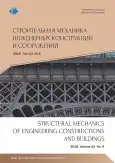Особенности работы каркасов большепролетных металлических куполов в процессе их возведения
- Авторы: Лебедь Е.В.1
-
Учреждения:
- Национальный исследовательский Московский государственный строительный университет
- Выпуск: Том 14, № 6 (2018)
- Страницы: 481-494
- Раздел: Расчет и проектирование строительных конструкций
- URL: https://journal-vniispk.ru/1815-5235/article/view/346347
- DOI: https://doi.org/10.22363/1815-5235-2018-14-6-481-494
- ID: 346347
Цитировать
Полный текст
Аннотация
Цели. Дать характеристику процессу формирования каркасов большепролетных металлических куполов при их возведении. Выполнить анализ работы конструкций при монтаже купольных каркасов по расчетным схемам, отличающимся от проектной, из-за чего в их конструктивных элементах возникают монтажные усилия. Привести геометрические схемы купольных каркасов (ребристых, ребристо-кольцевых и сетчатых) и принципы их образования. Показать, как образуются сетчатые купольные каркасы, и объяснить, почему они являются пространственными стержневыми системами. Описать особенности конструктивных решений однопоясных и двухпоясных купольных каркасов. Отметить, что технологическая схема монтажа конструкций большепролетных металлических куполов зависит от конструктивного решения и способа возведения их каркасов. Вкратце охарактеризовать различные способы возведения каркасов большепролетных металлических куполов и количество применяемых при этом временных опор и механизмов. Обзор. Принципиально различные способы возведения, как реально примененные, иллюстративно показаны на примерах нескольких конкретных известных купольных сооружений мира. Дана оценка влияния каждого способа на работу конструкций в процессе монтажа. Описан характер работы отдельных конструкций и каркаса в процессе возведения большепролетных металлических куполов. Сделан акцент на существенные различия в характере работы конструктивных систем купольных каркасов при разных способах их монтажа. Исследование. Разработаны компьютерные модели однопоясных металлических куполов из стальных двутавров с жесткими сопряжениями в узлах. Созданы дополнительные модели неполного каркаса для исследования различных способов монтажа куполов. Для каждой монтажной модели купольного каркаса выполнены компьютерные расчеты на действие собственного веса. В результате расчетов определены напряжения в конструктивных элементах каркасов, которые сравнивались с напряжениями соответствующих элементов на действие собственного веса в каркасе проектной схемы. Результаты. Сделан вывод о неизбежности появления напряжений в элементах каркасов большепролетных металлических куполов при их возведении. Отмечена необходимость обязательных расчетов каркасов на монтажные состояния при проектировании большепролетных металлических куполов.
Об авторах
Евгений Васильевич Лебедь
Национальный исследовательский Московский государственный строительный университет
Автор, ответственный за переписку.
Email: evglebed@mail.ru
кандидат технических наук, доцент, кафедра металлических и деревянных конструкций
Российская Федерация, 129337, Москва, Ярославское шоссе, 26Список литературы
- Gokhar’-Harmadaryan I.G. (1978). Bol’sheproletnye kupol’nye zdaniya [Wide-Span Dome Buildings]. Мoscow, Stroyizdat Publ., 150. (In Russ.)
- Krivoshapko S.N. (2014). Metal ribbed-and-circular and lattice shells from the XIXth until the first half of the XXth century. Structural Mechanics of Engineering Constructions and Buildings, (6), 4–15.
- Torkatyuk V.I. (1985). Montazh konstrukziy bol’sheproletnyh zdaniy [Installation of Structures of LargeSpan Buildings]. Moscow, Stroyizdat Publ., 170. (In Russ.)
- Kuznetsov V.V. (Ed.). (1998). Metallicheskie konstruktsii. Tom. 2. Stal’nye konstruktsii zdaniy i sooruzheniy. Spravochnik proektirovshchika [Metal Structures. Vol. 2. Steel structures of buildings and constructions. Reference book of the designer]. Moscow, ASV Publ., 512. (In Russ.)
- Gofshteyn G.E., Kim V.G., Nishchev V.N., Sokolova A.D. (2004). Montazh metallicheskikh i zhelezobetonnykh konstrukziy [Installation of Metal and Reinforced Concrete Structures]. Moscow, Stroyizdat Publ., 528. (In Russ.)
- Lebed E.V., Alukaev A.U. (2018). Large-span metal dome roofs and their construction. Structural Mechanics of Engineering Constructions and Buildings, 14(1), 4–16.
- Mukaiyama Y., Fujino T., Kuroiwa Y., Ueki T. (2009). Erection Methods for Space Structures. Evolution and Trends in Design, Analysis and Construction of Shell and Spatial Structures. Proceedings of the International Association for Shell and Spatial Structures (IASS) Symposium 2009, 28 September – 2 October, Valencia. Spain, Universidad Politecnica de Valencia, 1951–1962.
- Scotty Moore. (2017, March 18). Charlotte Coliseum. Charlotte, NC. Available at: http://scottymoore.net/ charlotteColiseum.html
- ZAO Stalmontazh. (2017, March 14). Proektirovanie, izgotovlenie, montazh stalnyh konstruktcyi. Nashi ob’ekty. Arena-Sever [Design, production, installation of steel structures. Our objects. Arena-Sever.]. Available at: http://www.stalmon.ru/nashi/57
- Louis O., Bass A.M. (1965). Unusual Dome awaits Baseball Season in Houston. Civil Engineering, 35(1), 63–65.
- Thor L. Anderson. (1974). Le stade couvert polyvalent “Louisiana Superdome” à la Nouvelle-Orléans (EtatsUnis). Acier, 39(3), 113–119.
- UK Sovintekh. (2017, April 16). Kupol torgovogo tsentra “Global Siti” [Dome of shopping center Global City]. Available at: http://feedevelop.ru/ourdoneprojects/ 2-building/54-montagkupola
- Ruzhansky I.L. (2005). Opyt proektirovaniya i sooruzheniya setchatyh kupolov [Experience of design and construction of mesh domes]. Montazhnye i spetsial’nye raboty v stroitel’stve [Construction and Special Works in Civil Engineering], (11), 22–26. (In Russ.)
- TSNIIPSK im. Mel’nikova. STAKO. (2017, March 14). Kupol elektrodepo Moskovskoi monorel’sovoi transportnoi sistemy [Dome of electrodepot of the Moscow monorail transport system]. Available at: http://www. stako.ru/catalog/109/
- MCM DAILY. Bucky Gallery. (2017, March 19). Photos of the construction of Buckminster Fuller's Geodesic dome, the US pavilion at Expo 67, Montreal. Available at: https://www.mcmdaily.com/gallery/bucky/
- Chudesa prirody. Сhudolike – samye krasivye i samye udivitel.nye mesta nashey planety [Nature miracles. Сhudolike – The most beautiful and most interesting places of our planet]. (2017, October 21). Monreal’skaya biosfera – udivitel’nyi muzey [The Montreal biosphere – the surprising museum]. Available at: http://chudolike.ru/ canada/monrealskaya-biosfera-udivitelnyj-muzej.html
- Lebed E.V. (2018). Computer analysis of the behavior of large-span metal domes with different methods of installation. Structural Mechanics of Engineering Constructions and Buildings, 14(4), 261–272. (In Russ.)
- Karpilovskiy V.S., Kriksunov E.Z., Malyarenko A.A., Perel’muter A.V., Perel’muter M.A. (2004). SCAD Office. Vychislitel’ny kompleks SCAD [Computer system SCAD]. Moscow, ASV Publ., 592. (In Russ.)
Дополнительные файлы









